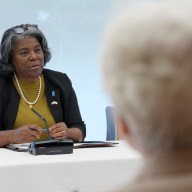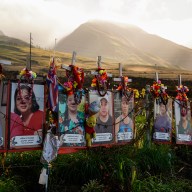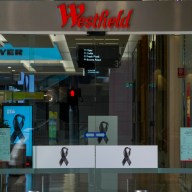 Forty-one percent of New York City residents report never wearing sunglasses outside, found The Vision Council. Make sure yours actually boast UVA/UVB protection and aren’t just dipped in tint.
Forty-one percent of New York City residents report never wearing sunglasses outside, found The Vision Council. Make sure yours actually boast UVA/UVB protection and aren’t just dipped in tint.
Credit: Digital Vision
You know to apply (and reapply!) sunscreen. You know to buy the broad-spectrum kind. You know that you should get weird looking moles checked out. But what you don’t know about sun protection could mean the difference between a summer on the beach and one on the operating table.
We asked derms to fill us in on the beyond-basic skin rules you need to know for protecting yourself this summer.
You need sunscreen every. single. day.
Yes, even when it’s cloudy, raining, sleeting — you get the idea. The sun beams out UVA and UVB rays — the latter are the sun’s most damaging rays during the summer months, in the middle of the day, says Dr. Neal Shultz, a New York City dermatologist. But it’s the UVA rays that are “more plentiful and present all year long, and at all times of the day, and much more important in causing premature aging and causing skin cancer,” he says. Put your sunscreen on as the first layer of products you apply to your face each morning — that means it goes under your makeup, ladies.
you don’t know you’ve missed,” says Shultz. Convenient? Yes. Dependable? Not quite.
You don’t really need SPF 100
You might think you’re doing your body some extra good, but really, even a 15 provides almost 90 percent coverage from the sun’s rays (an SPF 30 provides over 95 percent coverage, and an SPF 50 provides 99 percent plus). But don’t get too cozy, regardless of the number: “Whether the SPF is 15, 30 or 100, it needs to reapplied with the same frequency,” Shultz says.
Boozing? You’re more likely to burn
Nothing beats laying poolside with a cocktail, but when you’re drinking your skin is way more vulnerable to the sun. That’s because alcohol dilates your blood vessels, meaning there’s more red in your skin, and “the pinker the skin, the closer the blood cells are to the surface — and therefore, they absorb more damaging UV,” Shultz says.
You can get skin cancer in spots that aren’t exposed to the sun
Even if you’re not sunbathing in the nude, you can still get skin cancer in your groin and anus (apologies for the visual). Other weird places you can get it? Your mucus membranes, like inside your nose and mouth. Have a dentist check inside your mouth for splotches, recommends Dr. Sapna Patel, assistant professor of melanoma medical oncology at the University of Texas MD Anderson Cancer Center.
You can also get melanoma, believe it or not, behind your eye. Make sure you see an ophthalmologist once a year for a full exam (including dilating your pupils — sorry!) to ensure nothing funky is going on in the back of the eye, which produces skin cells just like the rest of your body. And at your derm’s office, make sure your doc gets in all your nooks and crannies: “You should feel invaded,” says Patel. Don’t wear nail polish to the appointment — skin cancer can lurk even in your nailbeds.
If it bleeds, it leads
You’ve likely heard the ABCDE of spotting skin cancer: Look for moles that are asymmetrical, have an irregular border, have a funky color, are bigger in diameter than the size of a pencil eraser, and/or have evolved over time. But that B could also stand for bleeding: A mole that gets bloody with minimal trauma is something to watch out for, says Patel. “Most benign things shouldn’t have a blood vessel in them — it’s malignant things that are digging in and growing roots.”
Free screenings
The Skin Cancer Foundation is providing free full-body screenings by dermatologists at Rite Aid locations throughout the country. The Road to Healthy Skin Tour sets out on Tuesday and will make its way around New England before crossing to the West Coast. Four dermatologists will be on hand to provide quick screenings. You can also learn how to do monthly checks at home and get free sun-protection product samples. Skin cancers found and removed early are almost always curable, so the foundation advises getting checked annually. For more information, visit SkinCancer.org/Tour.
Decoding melanoma
The process of how healthy skin cells turn into cancerous melanoma cells has been decoded by Oregon State University researchers.
“We believe this is a breakthrough in understanding exactly what leads to cancer formation in melanoma,” said Arup Indra, an associate professor in the OSU College of Pharmacy. “We’ve found that some of the mechanisms which ordinarily prevent cancer are being switched around and actually help promote it.”
A protein called RXR is normally part of the skin’s immune response, helping to produce the skin pigment melanin in response to sun exposure. But when RXR levels are too low, the genetic damage that skin cells routinely suffer cannot be repaired.
This process had not been understood entirely, Indra said, and the new findings could lead to diagnostic tests to gauge RXR levels, as well as diets and treatments to boost the body’s production of the protein.
More than 70,000 cases of melanoma, the deadliest form of skin cancer, develop in the U.S. every year.
















